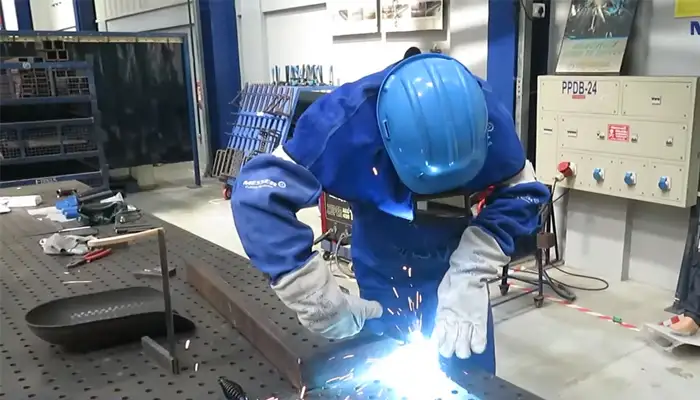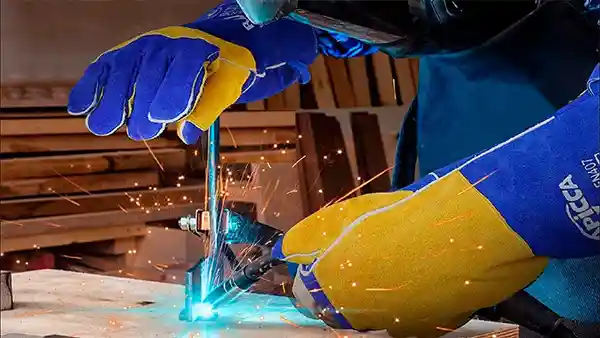Phone:
(701)814-6992
Physical address:
6296 Donnelly Plaza
Ratkeville, Bahamas.

Working with welding projects involves precision and skill, controlling the arc gun in one hand while guiding an electrode along metal with the other. It takes dexterity to keep a steady grip on both tools for optimum results. You may now wonder, do you need to wear gloves when welding?
There is no doubt about it. Since when welding, the protective covers on an arc gun may not always guarantee full protection for your hands from electrical currents. To ensure safety and avoid potential shocks or burns, it is highly recommended to wear gloves while welding.
Working with welding equipment can be dangerous as the intense heat created during this process presents a significant risk of burning your hands. To prevent harm from occurring, it is essential to wear protective gloves, and below we will delve further into why this is so important.

When welding, you must always wear the best heat resistant welding gloves with the right size to keep your hands safe and protected. Welding is a dangerous activity that can result in serious burns, electrical shocks, and even death.
The risks are even greater when welding is done in close quarters, such as in shipyards or other industrial settings.
A number of factors contribute to the need for gloves when welding. Below are some of the most important reasons:
1. Heat and Burn Protection: If you’ve ever welded before, you know just how hot the sparks can get. In fact, the heat generated by welding can reach incredibly high temperatures.
Without gloves, your hands would be vulnerable to severe burns. Wearing heat resistant gloves protects from the heat, sparks, and spatter generated during welding.
Aside from protecting your hands from heat, gloves also help to protect your skin from the harmful effects of ultraviolet radiation. Prolonged exposure to UV radiation can cause skin cancer.
2. Protect Your Hands from Electrical Shock: Since welding involves electricity, there is always a risk of electrical shock. Wearing gloves helps to insulate your hands from the electricity, preventing you from being shocked.
Due to the materials used to construct welding gloves, they are electrical shock resistant, making them an essential piece of safety equipment.
When you wear welding gloves, you can rest assured that your hand is protected from the dangers of electrical shock. Gloves provide a protective barrier between the user and the electrical current, ensuring that the user remains safe.
3. Improve Your Grip on the Electrode: It is vital that you maintain a firm grip on the electrode while welding. Otherwise, you run the risk of dropping it or losing control of it.
Wearing gloves can help improve your grip and give you more control over the electrode. This is especially important when welding in tight spaces or on vertical surfaces. Having a good grip will allow you to weld more accurately and safely.
4. Keep Sharp Objects Away from Your Hands: Sharp objects are one of the most common causes of welding accidents. If you are not careful, you can easily cut yourself on a sharp edge or piece of metal.
Welding gloves can help protect your hands from sharp objects. They are made of tough, durable split leather that is resistant to cuts and punctures. The leather glove also has reinforced seams that help to prevent them from tearing.
There is an inner lining in the gloves that helps to absorb shock and protects your hands from the heat of the welding process. Consequently, welding gloves can provide an important level of protection when working with sharp objects.
5. Keep Your Hands Clean: The electrode and arc gun can get very dirty when you weld. This contaminant can transfer to your hands, making them dirty as well.
Wearing gloves will help to keep your hands clean and free from contaminants. This is important for maintaining good hygiene and preventing the spread of infection.
6. Prevents Skin Irritation: When welding, you are exposed to a variety of harmful chemicals and fumes. These fumes can cause skin irritation, especially if you have sensitive skin.
Wearing gloves will protect against these irritants and keep your hands healthy, so you can continue working without interruption.
7. Improve Your Comfort Level: When you wear gloves while welding, you will be more comfortable. This is because the gloves will help to absorb the vibrations from the welding process.
The gloves will also help to keep your hands warm, which is important when working in cold environments.
Even in warm environments, gloves can help to absorb sweat and keep your hands dry. This will improve your comfort level and prevent you from getting fatigued.
8. Allows You to Handle Hot Objects: Sometimes, you may need to handle hot objects while welding. For example, you may need to adjust the electrode or move a piece of metal that is too hot to touch with your bare hands.
Wearing gloves will allow you to handle these hot objects without burning yourself. The gloves will insulate your hands from the heat, preventing you from being burned.

It is not recommended to wear regular gloves while welding. The materials used in welding gloves are designed to withstand high temperatures and provide protection against sparks and other hot objects.
If your hands come into contact with a spark, regular gloves, especially those made of cotton or wool, may catch fire.
Regular gloves can hinder dexterity and make it more difficult for you to grasp the torch and other welding tools, making welding more difficult.
Welding gloves are often thicker than regular gloves, which provides additional protection from burns. You should invest in quality welding gloves if you intend to weld.

Depending on what kind of welding you are performing, this will vary. For example, if you are doing arc welding, you will need to use gloves that are made of a material that is resistant to heat and sparks.
Leather welding gloves are a popular choice because they are durable and can withstand high temperatures. If you are doing MIG welding, there are special gloves made from heat-resistant materials that still allow you to grip the electrode.
MIG welding gloves are typically made of thick leather with a Kevlar lining. This will help to protect your hands from the heat generated during the welding process while still allowing you to have a good grip on the electrode.
To perform TIG welding, it is necessary to wear gloves that have good heat resistance and provide good dexterity. TIG gloves usually consist of thin leather. You can thus maintain good control over the electrode while still being protected from the heat.
When choosing welding gloves, selecting a pair that is comfortable and fits well is essential. You should also ensure that the gloves are rated for the type of welding you are doing.
In this manner, you can be certain that you are wearing the appropriate protective gear for the particular task.

While most welding gloves are made with fire-resistant materials, they are not technically fireproof. This is because even the welding gloves will eventually break down when exposed to high temperatures for a long time.
Welding gloves can provide a significant amount of protection against burns. An average welding glove can withstand temperatures of up to 2000°F for short periods. Typical welding gloves can only withstand temperatures up to 600 degrees Fahrenheit during long-term use.
The key is to choose a pair that’s rated for the level of heat you’ll be handling. For example, if you are using a welding torch that emits temperatures up to 1,000 degrees Fahrenheit, you will need a glove that is rated for that temperature range.
As a general rule, the higher the temperature rating of the welding gloves, the greater the protection against burns they will provide.

One of the challenges with welding gloves is that they can shrink over time, especially if exposed to high temperatures beyond their capability.
This can make it difficult to get a good fit, which can impact your dexterity and cause you to lose your grip on the torch or other welding tools. To prevent this from happening, you may use a heat shield.
A heat shield is a piece of fire blanket material that slides over the glove finger, protecting it from the heat of the arc. This allows the welder to keep their hand closer to the heat source, if necessary, without damaging the glove.
The other option is to purchase welding gloves made from a material that is less likely to shrink. The use of gloves rated for lower temperatures should be avoided, as these are more likely to shrink when exposed to high temperatures.
Gloves are a must-have for welders, as they provide essential protection from intense temperatures and potential burns. Besides safeguarding your hands, gloves also give you the dexterity necessary to wield welding tools effectively, making them an essential part of any welder’s safety arsenal.
Investing in a quality pair of specialized welding gloves will guard your hands against harm while you take on any challenging welding projects. Don’t make do with regular work or garden gloves. Select one that’s up for high-temperature protection.
So, before striking up your next welding project, make sure to consider not only what type of job you’re doing but also which glove features will best suit your needs for maximum protection.